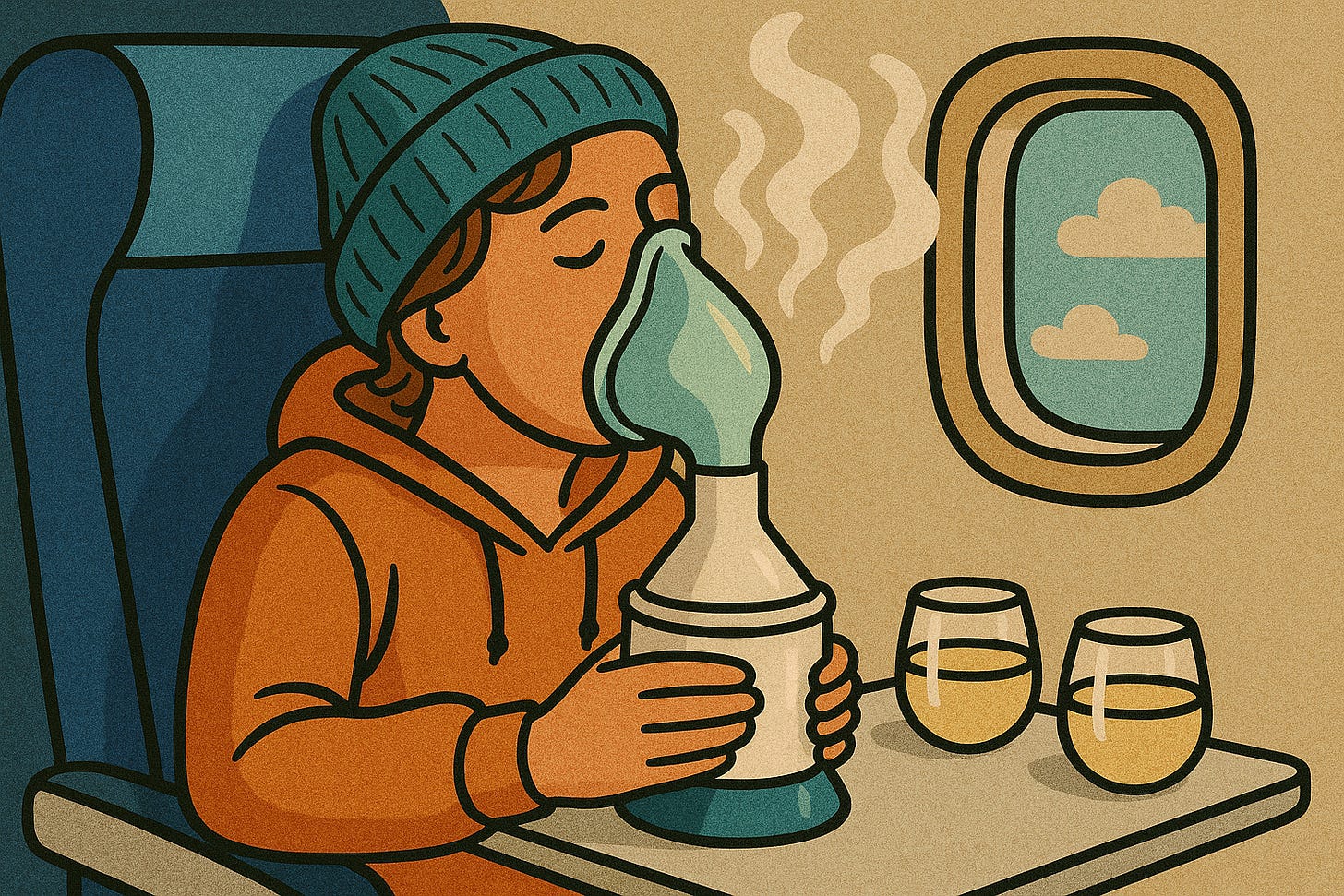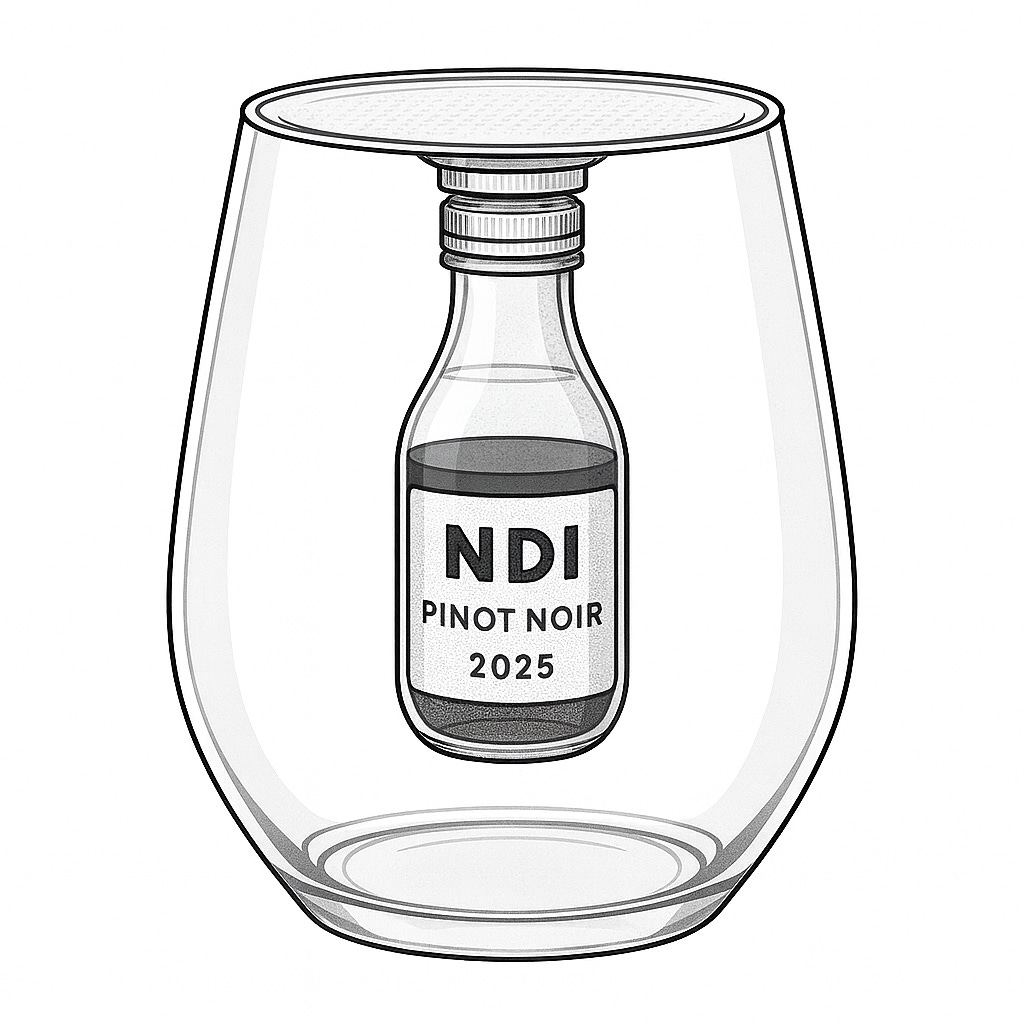Turn flights into wine tasting rooms
In a tough environment for the American wine industry, it might be time for some radical new ideas. Are 50mL airplane bottles the future of wine?
If you’ve ever visited a winery, you’ve probably done a tasting. This is a common marketing tactic especially loved by small to mid-sized wineries: show customers they like your wine, show them a good time, and sell them a few bottles before they go.
It's historically been a successful model. But wineries today are increasingly struggling in a tough environment. More competition and overproduction has coincided with an overall decline in consumer demand from decreasing alcohol consumption. At the same time, growing anti-American sentiment from tariffs has been a major hit to American wineries’ ability to compete in export markets.
One of the few bright spots is direct to consumer (DTC) sales — nearly 90% of revenue for smaller wineries. The best kind of DTC sales come from the wine club: a subscription offering regular wine shipments and discounted bottles. If you dig into the excellent SVB reports on the wine industry, it’s clear that small wineries disproportionately rely on in-person wine tastings to recruit for their wine clubs. The main alternative — digital acquisition — only makes up ~10% of wine club revenue for smaller wineries, compared to 20%+ for larger ones.
It makes sense. Big wineries can use their brand to attract joiners to the club, while a small family-owned winery relies on word of mouth and the tasting room experience to get people to try their production. More remote wineries may also struggle to properly sample wines for their members, forcing them to choose new wine shipments blindly.
Reader Adam Weir wrote in with a solution for America’s small wineries: package new wines in 50mL bottles, commonly known as “airplane bottles”, and send them as samplers to members and potential new customers.
Wineries don’t go that small today
The standard winery bottle size is 750mL, enough for roughly 4-5 glasses. Most other bottles just go bigger; 1.5L or 3L, for when you’re a restaurant or having a particularly wild party. But a bit under 10% of the US market goes smaller — either a half bottle (375mL), or the somewhat-rare 187mL single glass bottle.
If you order a glass of wine on an airplane, the 187mL size is probably what you’re getting. It’s as small as you can get, but poorly suited for tastings; a typical tasting pour is about ⅓ as large, meaning you’re either overserving one person or requiring them to find others to split with.
A 50mL bottle provides an almost-perfect serving for an individual tasting. But wineries never offer this size, and for good reason — it's too small to enjoy outside of a tasting setting, and producing new SKUs and bottles is expensive. Worse, they lack some of the branding power of a fine winery; airplane bottles are usually used for a stealthy shot, not savoring a fine merlot.
But there are real advantages to the portability, particularly around distribution channels. Instead of sending a rep to give wine samples, wineries could package a 5-wine sampler into a single package to sell at liquor and wine stores. Not only does this create a novel experience for the customer, it gives customers a cheaper entry point while pushing customers towards higher-margin direct to consumer purchases.
Given an in-room experience can cost $20 to well over $100, a 5-sample bundle could be a good deal at $10 to $20. But wineries could charge more and let buyers roll the upfront cost into a wine club membership or direct bottle sales. If they get the experience right, the airplane bottle could be a powerful customer acquisition tool.
Designing the miniature tasting experience
A small bottle isn’t the optimal consumption mechanism for a glass of wine. You need to be able to smell the wine, look at the color, and let it breathe. The ritual is important. But if you buy a pack of 5 airplane bottles, you’re locked into needing to find wine glasses — not always convenient, especially when buying these as a gift.
There needs to be some product innovation. My idea: stemless wine glasses with the 50mL bottle attached to a lid, peeled off when it's time to serve.
This allows for a single-serve packaging for the full wine tasting, ready to be served anytime, anywhere. For the right manufacturing partner, there could be a lot of lucrative dealmaking done in the wine industry.
And the manufacturing will be important. This is an entirely novel production line; most new manufacturing processes have a multi-thousand dollar upfront cost for a mold that requires tens of thousands of units to pay for.
Unfortunately, it’s quite impractical for a small winery to take the lead in production. Most small wineries only produce a few thousand bottles per year; setting up a manufacturing line is silly for them.
Worse, the logistics are tricky. As wine enthusiasts know, large bottles of wine age slower than small ones. The higher oxygen to wine ratio in small bottles causes more rapid oxidation. In other words, you need to drink it relatively quickly — long stored inventory is a fast track to expiration. That means frequent restocking and turnover, unrealistic for smaller wineries.
The solution: a separate business that handles bottling for the 50mL packages. This centralized distributor can partner with individual wineries, co-pack their products into these containers, and distribute them to partners. This separate company gains the ability to substitute across wineries as wine clubs fill, consistently give new product, and innovate on packaging.
I think wineries would rush to sign up for this. Customer acquisition costs (CAC) just for a wine room visit are reportedly $60-$120; with wine club membership conversion being closer to 5%, that implies a CAC for wine clubs of $1,200 to $2,4001. Reaching an audience that indicates interest through buying a sample pack is almost certainly a great deal for them.
But liquor stores might be reluctant to sell these. This is a product explicitly designed to cut out the distributors and retailers; when wine stores realize they’re seeding DTC, it’s unlikely they’ll order another set.
Maybe wineries aren’t the right distributor. There is one place where alcohol is regularly served. A place with a captive audience of higher-income customers. A location inspired by the 50mL bottle: an airplane.
Tastings in the sky
These are sort of perfect for air travel.
Flights are the only place in the world where you can find a few hundred people stuck for a 3-6 hour period. It’s a captive audience that’s bored, stuck, and has disposable income. It’s sort of weird that there isn’t more effort put into selling experiences to passengers.
Wine tasting in the past would have been too burdensome on attendants. But with all-in-one packaging, wine tastings can be quickly sold and done unsupervised. Airlines can easily upsell additional food purchases like cheese and crackers.
Even better, premium economy fliers might be the perfect customer. They’re disproportionately higher income and have already displayed a willingness to pay a premium for better service. Selling one of these packs for a $15 down payment on a wine club is a high-touch point of connection with their ideal customer; there’s a lot of power in being a brand new experience in a familiar space.
Wine connoisseurs might be thinking: “isn’t an airplane the worst possible place to try a wine?” You have a point, hypothetical reader: food famously tastes worse on airplanes, with taste buds weakened due to low pressure and dryness. The resulting dry nasal cavities weaken the sense of smell, a major issue for the wine tasting experience.
Today airlines solve this through intensity: saltier meals, stronger tastes, and spicy cocktails. That doesn’t work for wine, but that doesn’t mean there aren’t alternatives.
Ahead of drinking the wine, flight attendants could provide moisturization — water, a wet towel, some nasal saline, or (for tough cases) a steam inhaler — to re-hydrate ahead of a tasting. And given that dryness is the bigger taste-culprit (your cabin is a little lower pressure than Denver, and there are in fact wine tastings there), this may get taste buds to an acceptable level.
Especially as a novelty, the experience of an air tasting — with a hot towel over your face to open your senses, followed by a sampling from a small local winery — is certain to get some word of mouth attention, helping push the idea beyond premium economy into the public consciousness.

As the wineries partnering with airlines sell out, you could imagine a gold rush of wineries trying to become the next sampler on the list. Airlines could begin doing themes based on the region: a flight to the Bay Area could feature Napa wines, while a flight to Oregon could offer a Willamette Valley Pinot Noir.
With wineries competing over access to this valuable customer group, they might start cutting airlines into the deal and give them a commission on wine club sales that originate on their flights. Airlines might begin to bring their frequent flier programs into the mix, offering points on wine purchases and letting fliers redeem points to get a wine sample.
Other consumables might begin competing for this market. It seems natural that chocolate makers, specialty coffee roasters, and breweries might create their own samples to push on airlines in a mad dash for partnerships. In the same way that most airlines are negative operating margin without credit card points, subscription models in the cabin might become a subsidy to keep ticket prices low.
Maybe it all ends with wineries reverse-integrating with airlines; the micro-winery, micro-brewery, micro-chocolatier, and micro-roastery all become part of the Delta suite of products. It’s not enough for 1% of US GDP to go through Delta; the real flex is 1% of US specialty grocery purchases originating on a Delta flight.
Official idea rating
4.5/5. At first this seemed like a silly idea, but the more I learned about the wine industry — the struggles of small wineries in the DTC market, the overproduction of US wine, and the price pressure small wineries are facing — the more I think this might be the perfect time to do something like this.
Of course, my bottle design is mediocre and I’ve glossed over all of the pain setting up this manufacturing process would take. The first generation of glasses will break. Some batches would go bad. There would be supply issues. A lawyer needs to look at FAA regulations (which don’t seem to be an issue to me but I am not a lawyer).
But for an entrepreneur plugged into the wine industry, discovery as a service is massively valuable. In an era where there’s unusual pressure on small wineries, the right founder has the opportunity to secure a lot of meetings. Just don’t forget to send me an NDI branded bottle in recognition that you read it here first.
$60-$120 tasting room ÷ 5% conversion rate = $1,200-$2400 CAC for wine clubs



https://news.delta.com/culinary-takeoff-delta-brings-new-wine-selections-and-chef-designed-meals-onboard
Delta already has a Sky Sommelier 😂